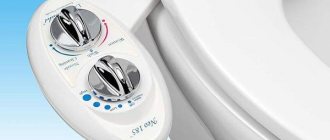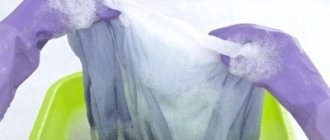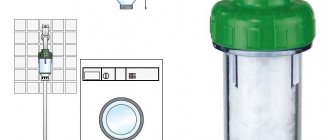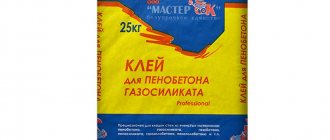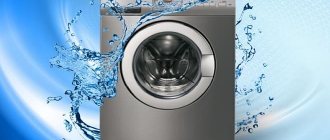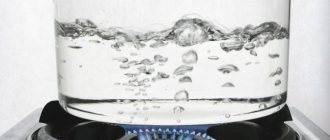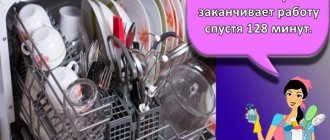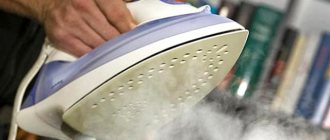Author of the article
Alexander Georgievich Kondratiev
An electrical engineer by training, he worked as an electronics engineer, chief engineer at a food company, and general director of a construction organization.
Regular increases in utility tariffs force owners to save water. There are many ways to rationally use water in everyday life. If you use them regularly, they can help you save up to 10,000 rubles a year.
These are absolutely legal methods, but they only work in apartments with meters.
Saving water in the bathroom and shower
When people practice hygiene, the priority is to save hot rather than cold water.
To achieve maximum results, you need to avoid frequent bathing. Give preference to a shower, as water consumption in this case is significantly reduced. During water procedures with medium pressure, approximately 13-14 liters are consumed. liquids per minute. A quarter-hour shower uses much less water than a full bath. There are also many shower heads on the faucet, which, in turn, are designed to save water. Installing a lotion will reduce the flow rate to 5-6 liters per minute. The principle of operation of the nozzle is quite simple: water is dispersed inside the device, so the process does not deteriorate.
Install a faucet with one lever that immediately mixes 2 streams of water (hot and cold), minimizing consumption. Post a visual reminder about saving water in your home. This will serve as a constant reminder for household members who often do not strive to save family money (the younger generation).
Remember to turn off the water when you are not using it. This must be done when brushing your teeth, shaving, rinsing your mouth, washing your face with a scrub and other cosmetic procedures. If we talk about indicators, the listed methods can save up to 12 cubic meters of water per year.
How much can you reduce water consumption?
With a competent approach to water consumption in an apartment, it is possible to significantly reduce resource consumption.
Savings can reach 50% when washing hands, 73% when washing dishes, and 75% when brushing teeth . It is possible to further reduce water consumption during shaving. Savings can reach 88%.
With proper use of the resource, 1 person can save up to 13 liters per day. In a month, savings can amount to 390 liters, and in a year – 4745 liters.
A family of 4 people is able to reduce water consumption by 52 liters per day. In a month, savings can exceed 1,500 liters, and in a year – almost 19,000.
Saving water in the bathroom
Some of the above tips apply to the bathroom as well. For example, the use of water-saving nozzles (including shower heads) or sink plugs. The following little tricks will help you save water as much as possible in an apartment with a meter.
1. Check the toilet thoroughly for leaks. This can be done by adding a little dye to the tank. If the water in the toilet changes color after a while, it means the system is faulty and needs to be repaired or replaced.
2. Old toilets were designed without taking into account saving water, so each time they mercilessly drain 10-13 liters into the sewer. Replace it with a more modern one, which requires 5 liters for a high-quality flush, and for some even 3. The two-button flush is the greatest invention of mankind, allowing you to save a significant amount of water.
3. If it is not possible to replace the toilet, you can reduce the volume of flushed water using “folk” methods. Place one or more plastic bottles filled with water in the tank, securing them so that they do not dangle and interfere with the operation of the mechanism. By displacing 2-3 liters of water in this way, you will reduce the drain volume by the same number of liters. At the same time, you can demonstrate to children the practical application of Archimedes' law.
4. We have already talked about the fact that a shower is three times more economical than a bath in How many liters of water are in a regular bath. This is true with a small amendment: the shower should be “quick”. Consider for yourself, a standard bathtub (with you) will fit approximately 150 liters of water. And the shower consumes up to 15 liters per minute. It turns out that if you wash for more than 10 minutes, singing arias or playing with soap bubbles, then it will be more economical to do it in the bath than in the shower.
5. When taking a shower, try not only to reduce the time spent under it, but also turn off the water when it is not needed. Wetted ourselves - turned off the tap, soaped ourselves, then opened it. Do the same in the sink, while shaving or brushing your teeth.
6. If you need to rinse your hands, do not open the tap completely, but only partially. Try to use cold water instead of hot water.
7. Don’t confuse the trash can with the toilet by throwing everything in it and flushing it every time.
Cistern with two buttons
A lot of liquid is lost when flushing the toilet. Each button press consumes 10-15 liters. Some owners place a bottle of water inside the tank to reduce consumption. Thus, they achieve a reduction in losses by 1.5 liters with each flush.
But this figure can be significantly reduced if you use a tank with two keys. This tank operates in two modes. When you press the first button, a small amount of liquid is drained.
Depending on the toilet setting, 2-5 liters are flushed. And when you press the second button, the tank drains the water into the toilet in full.
Drop by drop and the ocean
Perhaps older readers remember this song from a cartoon from the time of perestroika. Many have begun to understand its relevance only now, when the increase in the cost of utilities is racing against the decline in income.
Saving water should begin precisely by looking for such “drops” that drain your family budget. It could be a leaky faucet, a leaky pipe, or a broken toilet tank mechanism.
More or less serious leaks can be detected using a simple method. When leaving home in the morning, write down the meter readings and check them in the evening. If they have changed, it means that you have large water losses in your apartment. If you remain in place, do not rush to rejoice, because the meter may simply not respond to small “diggings”.
The results of my small experiment showed the following. If one drop falls from a tap per second, then a little less than a liter of water is drawn in an hour. This is approximately 22 liters per day, 660 per month, almost 8,000 per year. Needless to say, if we are talking about a trickle and not a drop, then the numbers will be much higher. Here's the ocean for you. Therefore, eliminate even minimal leaks in an apartment with a meter.
If your pressure constantly fluctuates or is too high, you can save a lot by installing a water pressure reducer at the entrance to the apartment.
Consequences of illegal methods
Illegal ways to save water can be called one word: fraud.
As a rule, this is a stop of meters, or a hidden connection to the water supply, bypassing the metering devices.
Both options are equivalent to theft of resources and can entail administrative (and sometimes criminal) liability in the form of large fines.
There are a large number of legal saving methods, so you should not resort to illegal technologies.
How to save water in the kitchen
The use of water in the kitchen is, in one way or another, related to food. It turns out that the less you cook and eat at home, the less you spend. Sometimes lunch in a nearby canteen or fast food establishment will cost even less than preparing it yourself. Plus saving time. True, this option is more suitable for bachelors and childless couples, so let’s still go back to our kitchen and see how we can reduce water consumption.
1. When choosing a sink, give preference to one that has two trays. It opens up significantly more opportunities for saving water. In one compartment you can use a running stream, and the other can be closed with a stopper and used for washing vegetables or dishes.
2. Use special water-saving attachments for faucets. They can reduce water consumption by one and a half times.
3. Train yourself to pour into a saucepan or kettle exactly as much water as is needed for cooking or brewing tea. By pouring “with reserve”, you waste not only water, but also gas or light used for heating.
4 tips for saving your family budget
4. Everyone knows that microwave ovens have a defrosting function. But for some reason, many people, in the old fashioned way, put frozen meat in the sink, under running water. Like, why waste electricity? Commendable, of course, but since when did water become free? Believe me, the microwave will do its job faster and more economically. The best option is to leave the meat in the refrigerator overnight.
5. You should not try to wash off burnt or dried food residues by diligent rubbing under a hot stream. It will be much more economical to fill the dishes with water and leave them in the sink for a while. After just an hour, it will become much easier to wash.
6. It’s amazing how many housewives wash dishes under maximum water pressure. At the same time, they are sincerely surprised when they find out that after 4 people they spend up to 100 liters of water on washing plates. Therefore, if you want to save water in an apartment with a meter, you need to immediately get rid of this habit. Close the sink with a stopper, fill it with warm water, wash the dishes, and then just rinse them with running cold water with minimal pressure. You can wash vegetables and fruits in the same way.
7. Many people buy dishwashers to save time and get rid of routine work. And only then do they learn about another pleasant feature: the water consumption in the dishwasher is significantly lower than “manual” washing. Modern dishwashers spend from 10 to 15 liters per cycle. For maximum savings, use it only when fully loaded, optimally distributing items.
Cooking and washing dishes
Cooking food does not require as much water as washing it. However, there are ways to reduce consumption here too.
Do not defrost food under running water. Remove food from the freezer ahead of time. This will not only preserve water, but also beneficial substances will remain in the products.
Install a two-bowl sink. Soak dirty dishes in one, and use the second for rinsing. The savings will be significant if there are many people in the family. Use warm water to rinse.
If there is no special sink, dirty dishes can be washed in a basin. At the same time, you should not rinse the dishes under a strong jet pressure. This does not facilitate quick rinsing of dishes, but increases consumption.
Save money while washing
Don’t be lazy to spend 1-2 hours of your personal time to carefully study the instructions and find out how much water and electricity the machine spends on each program. The most expensive are long-term washing modes with double rinsing. Before loading, inspect the laundry, find out the degree of soiling and select the appropriate program.
- Wash with a full drum load.
- Treat stains with a high-quality stain remover or wash them by hand with laundry soap before loading the laundry into the machine. By doing this, you can choose a more economical mode.
- Don't use a double rinse if you can do a single rinse.
- Whenever possible, use the “quick wash” program; it is the most economical in all respects.
- Don't buy laundry detergents that don't rinse well. It is better not to use gels at all, firstly: they are difficult to rinse, and secondly: settling in a thin layer on the drum, in the filter and on the inner walls of the machine, it creates a breeding ground for fungi and microorganisms.
Learn how to get rid of mold in your washing machine.
Saving rules in Europe
European rules for saving water can be considered one of the sections of the general philosophy, the principle of which is: “saving means earning.”
Residents of European cities have long developed the habit of reducing water consumption when performing all hygiene procedures, including brushing their teeth, using a shower instead of a bath, etc.
In addition, almost every family uses dishwashers that operate with a full load. The same applies to washing equipment. The rules are simple, after a while they become a habit, and users stop considering them a burden for themselves.
Teeth cleaning
At first glance, it may seem that brushing your teeth uses less water than any of our other daily activities that use water. But if you keep the tap open for one minute, on average about 10 liters of water are consumed. How long will it take us to brush our teeth? According to experts, the entire process should last at least two minutes. And if we take into account that all this is done slowly and leisurely in the mornings when we are asleep, it turns out that at best we spend 3 minutes on brushing our teeth. It is easy to calculate that brushing your teeth takes 30 liters of water - without any special need. Meanwhile, this amount of water is enough to prevent dehydration and quench the thirst of the average person for 17 days.
Ways to reduce water consumption at home
To be careful about water use, it is advisable to reconsider some habits without giving up the rules of hygiene and comfort.
Method #1 - saving water in the bathroom
A traditional place that requires high water consumption is the bathroom. However, losses can be reduced by following simple recommendations. So, when brushing your teeth, it is enough to turn on the mixer only at the initial and final stages of the process. You should do the same when shaving.
To reduce water consumption when washing your hands, it is better to let the water flow in a small stream and bring your brushes close to the tap
A shower instead of a bath will reduce water consumption by 5-7 times. Savings will also come from reducing the time spent under the watering can, because in two minutes the shower loses up to 30 liters of water.
Those who aren't ready to give up their bath can cut costs by filling the bowl halfway. It is important to monitor the flowing water to prevent overflow.
Often, when you turn on the hot water supply, a cold stream flows from the tap during the first minutes. To prevent the liquid from going to waste, it can be collected in a container and used for useful purposes, for example, wet cleaning of the room.
Method #2 - wash at no cost
To remove dirt from linen and clothes, it is better to use modern washing machines. Additional savings will come from the use of equipment equipped with special sensors that help determine the exact amount of water required for washing clothes.
Machines with a front hatch save more water than their top-loading counterparts. It is advisable to use equipment class AA or higher
It is better to turn on the household device when the tank is fully loaded. Models with a half-load mode are considered a good option. In this case, you can wash several items using a minimum amount of water.
To reduce costs, it is better to give preference to machine washing with reduced water consumption. If you cannot do without handling the products by hand, to reduce liquid costs, it is advisable to rinse the laundry in a basin or bathtub, and not under a powerful stream of water from the tap.
Method #3 - save money in the bathroom
There are also tricks to reduce water consumption in the bathroom. This is, first of all, the purchase of modern, economical toilets with a dual flush system.
For older models, you can use a simple device: place a two-liter bottle filled with water in the tank. In this way, you can significantly reduce water consumption, saving up to 20 liters of liquid daily.
There is a double button on the lid of economical toilet models that allows you to use a full tank of water, the volume of which is 6-8 liters, or limit yourself to half the norm of 3-4 liters
Some users throw various small debris, food scraps, and cat litter into the sanitary container. This not only increases the risk of blockages, but also leads to increased water costs, since you have to use the drain more often.
Method #4 - wash dishes correctly
To reduce water consumption in the kitchen, the first thing you should consider is purchasing a dishwasher. When using this technique, only 13-15 liters of water are required to wash 9 sets of dishes.
It is important to run the dishwasher at full load with the chamber completely filled. For even greater savings, you can skip the initial rinse step.
Try to get into the habit of washing vegetables and fruits not from the tap, but in a bowl or sink filled with water. It is hardly advisable to defrost meat or other products under the mixer; it is better to leave them in the refrigerator in the evening
When washing dishes by hand, it is a good idea to use the European method. Dirty utensils are placed in a plugged sink and filled with water and detergent.
With a two-chamber sink, you can place dirty dishes in one bowl for initial processing, and in the second for rinsing. It is advisable to give preference to organic detergents, since they require less liquid to rinse off.
Method #5 - checking the condition of the plumbing
Excessive water consumption largely depends on the condition of the plumbing fixtures. It is estimated that 24 liters of water can leak through a dripping faucet per day, which amounts to 720 liters per month. We wrote about the causes of breakdowns and self-repair of the mixer in this article.
A water meter can help monitor the health of devices. If the numbers on the screen change when the taps are turned off, it is necessary to examine the risk areas and, possibly, call a specialist.
When traveling, especially long ones, it is better to turn off the taps on the pipes. This simple precaution will save you not only from unnecessary expenses, but also from major troubles.
It is better to change outdated models of taps, replacing them with at least single-lever mixers with a ceramic faucet. The most economical modifications are those with a thermostat or sensor, which we discussed in detail above.
Often, due to old fittings, water leaks occur in the cistern, which leads to additional costs.
In order to notice the problem in time, you need to add a little food coloring to the container at the first suspicion and wait 10-15 minutes. If colored streams appear in the drain, you will need the help of a plumber.
Installation of a special tap
Saving water can start with kitchen and bathroom remodels. You need to install one of these devices in them:
Faucet aerator. This device allows you to reduce water consumption by 25%. At the same time, the pressure remains the same. When the mixer with an aerator is turned on, the moisture flow is enriched with air bubbles. They prevent the water from splashing too much.
- Thermostat in the mixer. The device will not allow water heated to a certain temperature to flow from the tap. With this device you can save up to 3 liters of moisture per 1 tap turn on.
- Touch tap. The most effective tool for saving. Reduces water loss by 50%. But the cost of such devices is very high. The mixer turns on only when hands or dishes are brought near it.
Smart touch faucet
Engineers have come up with various gadgets to reduce consumption with foot pedals. But a more effective device is a touch mixer.
This “smart” gadget turns on the water only if a person brings his hands to it. An induction nozzle is built into it, which responds to changes in the magnetic field.
It changes when a person brings his hands to the tap. It fires and water is supplied. With such a gadget you can achieve up to 50% resource savings. The introduction is hampered by the high price of the mixer.
I share proven and most effective methods of saving water
Luckily, there are many ways to save money and avoid wasting water.
First of all, you should absolutely not keep the tap running while you brush your teeth. To do this, just a small glass of water is enough - and your water consumption will instantly be reduced from 30 liters to 300 milliliters.
Secondly, try to spend less time in the shower: the less time you spend standing, meditating (or chanting), the more you can save.
Thirdly, when you change the toilet during an apartment renovation, pay attention to dual-flush models - they can significantly save the amount of water by choosing the required flush volume. In addition, you should constantly monitor for leaks - according to experts, a leaking toilet can result in daily consumption of up to 260 liters of water
When washing dishes, try to use soapy water from the sink to remove major stains and only then rinse the plates under running water. Do not leave the dishes dirty for a long time - the leftover food will stick to the plates, and it will not be so easy to wash them later, which will require a lot more water. When it comes to dishwashers, don't rush through one dish, wait until the machine is fully loaded.
No one forbids you to take a bath whenever you want, but try not to do it every day. In addition, if you take a bath less often, then the pleasure from it will be incomparably higher.
Difference in savings for cold water and hot water meters
In houses, cold water is always consumed more than hot water . Therefore, more attention should be paid to saving cold water, since most of the consumption is accounted for by cold water. This is especially true when using the toilet, washing machine and taps in the kitchen and bathroom.
At the same time, tariffs for hot water supply are significantly higher than for cold water supply. Therefore, you should especially pay attention to the consumption of hot water when taking a shower and washing dishes.
The difference in savings compared to cold water supply lies in the subsequent payment of utilities. Without saving, hot water bills will come with large sums.
Repair all leaks
As the list shows, we lose up to 13,000 liters due to leaks alone. monthly is 13 cubic meters. Repair any leaks and adjust the toilet tank.
Aerator
This is perhaps the most affordable way to save. How does the aerator attachment help save water? The nozzle is screwed onto the spout of the faucet and, thanks to a system of fine meshes and dividers, mixes the flow of water with air, resulting in savings of 15 to 70% without loss of jet density. Passing through the mesh, the flow is softened, noise and the amount of splashes are reduced, and using such water is much more pleasant. At the same time, washing dishes or washing soap off your hands is no worse than with a fully open tap without an aerator.
When choosing aerators you need to proceed from your own needs. Experts have calculated that for comfortable use:
- Kitchen faucet (washing dishes or drawing water) has a capacity of 3-5 l/min.
- for a washbasin in the bathroom (minor washing, washing, brushing teeth) only 1.7-3 l/min.
- shower head 6-10 l.
- We consider it inappropriate to install an aerator on a bathtub faucet, since when filling the bathtub, we will fill 100-150 liters with or without a nozzle. With an aerator, this process will take twice as long, the water will cool down, and irritation will increase, especially if there is more than one person living in the house.
In standard mixers, from 10 to 16 liters pass per minute. water depending on the pressure and diameter of the tap.
Before purchasing an aerator, read its technical characteristics. Give preference to well-known companies that have already earned a good name. Don’t be too lazy to read reviews or additionally consult with experts, because often instead of water-saving nozzles they sell beautiful toys that give an intricate stream or are illuminated, but at the same time they consume the same amount of water as if they were not there at all.
The cost of aerators ranges from $0.6 to $16 per piece. It is very convenient to buy sets of 3 nozzles with different capacities: for the kitchen, for the washbasin and a limiter for the shower head.
Shower and faucet heads
To reduce water consumption, use a limiting attachment on your faucet faucet. The water flow through the nozzle does not flow freely, but through the o-ring. It narrows the passage of tap water, reducing fluid pressure. After the water pressure decreases, the reverse action begins, which opens up space for water to pass through.
These nozzles are universal, they have a standard size and are suitable for each mixer. The device is easy to install and does not spoil the appearance of plumbing fixtures and faucets. Many people wonder whether the nozzle saves water consumption.
We can confidently answer that yes. These nozzles reduce water consumption by 40-50%. In addition, they form a constant strong pressure in the tap, regardless of changing pressure.
In addition, you can install a nozzle with small holes on the shower head. This will help save water by 30-50%. For showers, special products with aerators are also used, which mix water with air. Such nozzles reduce consumption by 2.5-3 times. They are also great for massage.
We looked at how to reduce water consumption. However, it is equally important that the quality of water supply to houses and apartments is high. Remember that you should not overpay for poor pressure and poor quality water levels. Below you will see sanitary requirements and standards for providing houses and apartments with water supply, which must be followed by public utilities.
An illegal way to save water
Having considered legal ways to save, we can come to the conclusion that the amount of water charges will not change much. In such cases, you have to resort to using illegal methods of saving, namely:
- Using a magnet is the main and, in fact, the only illegal method, which entails a huge fine. For the most part, using a magnet in the meter results in huge water savings. But using a magnet will get you into big trouble.
- Various devices. At the moment, there are a huge number of different devices, which, as their creators assure, do an excellent job of saving water. The use of such devices can lead to various consequences with your meter and further fines, so their use is highly not recommended.
Remember, the system cannot be fooled. Organizations have had a computerized accounting program for a long time. There, subscribers whose water consumption suddenly became much less than it was before are marked in red. Not only statistics are taken into account, but also the number of people registered in the apartment. This means that the verification will not take long. By manipulating a magnet, you force respectable citizens to pay for themselves. Be smart and learn to save water legally.
Let replacing faucets, installing a dishwasher or replacing an old washing machine with a new one allow you to save a little less water than using a magnet or various appliances, which cause more troubles than positive aspects. However, the choice is yours!
Advantages of installing water meters
According to the Federal Law on Energy Saving No. 261-FZ of November 23, 2009 , all payments for resources, including water supply, must be carried out according to meter readings. In new buildings, water meters are installed before the buildings are put into operation.
In older housing stock, payments for water are charged according to consumption standards, unless apartment owners themselves think about purchasing individual devices. We have provided recommendations for choosing a suitable water meter here.
Installation of water meters is carried out by employees of the relevant services. Each device is supplied with a passport and a certificate of conformity, which is certified by a body accredited by Gosstandart
Experts strongly recommend thinking about installing water meters, because they have a number of undoubted advantages:
- A standardized payment is charged for each tenant registered at the address, even if he does not live in the apartment. And when the device is running, resource consumption is determined according to its readings, regardless of the number of people registered in the apartment.
- Actual water consumption is usually much lower than the upper limit of the norm.
It is worth adding that saving is important not only from the point of view of the family budget. Water is a non-renewable natural resource, the effective use of which contributes to the creation of a favorable environmental situation and protection of the environment.
Thinking about buying a meter? In this case, we recommend that you familiarize yourself with the rating of the best flow meters according to customers.
Responsibility for unauthorized interference with the operation of meters or how not to save on water
Management companies regularly check water meters. If the inspector finds damage on the meter that indicates attempts at tampering, this will lead to a significant fine.
To calculate the fine for damage to the meter, a special formula is used. It is necessary to take the average throughput of the water pipe and multiply it by the number of days during which the meter was damaged and was operating illegally.
If the inspector was unable to find out the last parameter, then the power of the pipe will be multiplied by the number of days that have passed since the last verification of the meter.
The fine amounts may be as follows:
- 300 rubles. This amount will have to be paid if the seal on the meter was broken accidentally and the controller recorded this fact in the report.
- The amount calculated using the formula given above and multiplied by 5. A fine is imposed for the use of magnets on meters or connections that bypass the meter.
- 300,000 rubles or 2 years in prison. The measure is provided for persistent violators who have repeatedly been caught in fraud with meters or who have unauthorizedly connected to the water supply.
Saving water is important. But today not everyone is concerned about the problem of moisture deficiency. People continue to perceive this resource as something inexhaustible. This is a big mistake, which, fortunately, is not too late to correct.
It is not entirely correct to say that the owner faces a fine for installing a magnet on the meter or as a result of other tampering with the device. Indeed, costs increase, but are associated with the recalculation of consumed resources. The issue is regulated by Decree of the Government of the Russian Federation dated May 6, 2011 N 354 “On the provision of utility services to owners and users of premises in residential and apartment buildings.” In particular, the recalculation is carried out on the basis of paragraph 64. Against the backdrop of causing significant harm, it is possible to be held accountable under Article 165 of the Criminal Code of the Russian Federation “Causing property damage by deception or abuse of trust.”
Magnet is illegal!
Often consumers resort to installing neodymium magnets on water meters . When water passes through the device, it begins to rotate in the opposite direction.
As a result, a situation of unaccounted consumption is created. Due to the revealed fact of using magnets on water meters, the consumer faces a fine. Its size is 10 times higher than the water tariff.
The consumer may also be charged with theft. In this case, he may be prosecuted. It can consist of either a fine or imprisonment.
You should only resort to legal methods of saving , since unauthorized attempts to reduce water consumption are quickly identified by the Criminal Code, after which consumers face liability, including criminal liability.
How to save water in an apartment using a meter; methods for saving fresh water
To register a water meter, you will need a number of documents:
- certificate of delivery and acceptance of the installed meter (it records the meter number, date of installation, information about the consumer, representatives of the installation organization);
- technical passport for the design device (indicates the date of installation and commissioning, as well as the primary indicators of the device);
- document on control of the water metering device (dates and information about meter checks are recorded, they are carried out every four years).
Water meters allow you to save water significantly, and also foster a thrifty attitude towards resource consumption. You will only have to pay for the water used, because without accounting devices, the bill amount is divided among registered residents.
Sources:
- Water footprint // Popular science encyclopedia “Water of Russia”
- Water footprint of production // WWF brochure
- Water statistics Eurostat
- Summary Progress Update 2022: SDG 6 – water and sanitation for all
- A Clean Water Crisis
- There are also unintended negative consequences of saving tap water: The Unintended Consequences of Water Conservation
- Water footprint of jeans: 1) A water footprint assessment of a pair of jeans: The influence of agricultural policies on the sustainability of consumer products 2) Water footprint of denim industry
- Water Footprint of Animal Products: A Global Assessment of the Water Footprint of Farm Animal Products
- Water footprint of livestock products and production systems: a review
- Water footprint of plant products
- Water footprint of paper bags: Plastic bags versus paper bags
Useful tips
These methods will help you save water in your apartment using the meter, and, accordingly, money in the family budget.
wash less frequently when there is enough laundry to fill the washing machine
It's better to do one big wash instead of several small ones. This will save you money and reduce costs.
take a shower instead of a bath
It is not only economical, but also healthy. It has excellent tonic effects and strengthens the circulatory system.
use less detergents
In this case, the savings are triple. You support the environment, reduce costs for detergents, and reduce water costs.
do not pour clean water in vain
Try to put every liter of clean, fresh liquid to good use. This will not only teach you to save money, but also respect nature.
don't pay for rusty water
If the management company violates the quality of the supplied resource, then by law you may not pay for it at all. For example, if water flows from a tap that is rusty or has an unpleasant odor, there are constant interruptions in its supply. In this case, you can go to court.
do not pay for water at the wrong temperature
The hot water in the tap must be at the appropriate temperature. According to the standards, the temperature range is 60-70ºС. If in fact the temperature is lower, then you can contact the management company to recalculate the amount for hot water.
buy a drinking water filter
This is typical mainly for large cities, where apartments have such chlorinated water that it is difficult to drink. Therefore, residents of megacities prefer to purchase bottled water for drinking. To save on this, purchase a special filter. Which will clean the liquid from foreign impurities and odors.
We often waste water without thinking about the fact that we are losing money. Many will answer that these are some pennies. But if you think about it and do the math, you can get an impressive amount in a year. Now you know how to save water in an apartment with a meter and not waste money in vain. If you have something to share, be sure to write comments. See you again!
What is the point of taking into account water for irrigation if there is a water cycle in nature?
The fact is that water is distributed disproportionately between countries . This is a huge global problem.
Unfortunately, those countries that need fresh water the most are forced to spend it on watering coffee and avocado plantations , while residents of more developed countries are most likely to enjoy aromatic coffee with avocado toast.
water travels along with food .
Key principles for saving water
Below are the key principles and rules that can help reduce water consumption in an apartment with a meter installed. By adhering to these simple rules, you can significantly save on payments for cold and hot water.
Installation of meters
The most effective way to save money is to install meters. Paying for water, based on the norms for the largest consumption, is very unprofitable. It makes more sense to pay the cost after the fact, especially if few people live in the apartment.
Meters will allow you to see with your own eyes how much water is spent throughout the month and adjust its use.
Plumbing is ok
Broken plumbing is not only annoying, but also empties the wallet of the owner of the living space. If the faucet or toilet side is leaking, fix it immediately!
A tap can drip up to 4 liters per day (all the taps in the apartment may leak if dishonest owners), and the current flush tank will use up to 14 liters!
A leaking toilet may be insignificant, and the breakdown is more difficult to notice than a broken faucet. To check the operation of the tank, we recommend adding a little dye to the water. If after a certain period of time the bottom of the toilet takes on a dye tint, then the tank is leaking.
We recommend installing a mixer on the tap; it will reduce water consumption (up to 50%), while the water pressure will not become weaker.
Shower instead of bath
Taking a bath, as we found out, is an expensive pleasure; approximately one bath consumes up to 100 liters of water. It is economical to take an ordinary shower; on average, the consumption will be 3 times less...
You shouldn’t deny yourself the pleasure of relaxing in the bath, but try to reduce the frequency of this procedure.
Water-saving shower head and water-saving faucets
The specialized water-saving shower head adopts a diffusion plate design with a small number of outlet holes (compared with a regular shower), making the water flow faster. Thanks to this design, while reducing water consumption, the pressure remains the same, plus it provides a feeling of relaxation.
As an option, use a specialized nozzle that allows you to save up to 50% of water consumption, thanks to the principle of mixing water with air entering through specialized holes in the housing. The built-in regulator reduces water consumption to 9 l/min.
Also, you can install specialized water-saving faucets in your apartment. Such economical faucets can significantly save water.
Cool water instead of hot
The principle is simple: cool water is more accessible than hot water; when doing housework, do not overuse hot water when you can use lukewarm water.
Not all homes have a dishwashing machine, as it is not an urgent need. But by washing each plate manually in running water, we spend more water than in a machine that washes dishes, which washes the entire volume of dishes at the same time, using water at a very low (inexpensive) temperature. Water consumption is reduced by 5 times.
Economical flush tanks (modern two-button)
The price of such a tank is higher, but little by little, due to water savings, the price difference will be compensated. The design takes into account a predetermined water volume for each button, and not the consumption of the entire volume of the tank in one flush, as happens in standard tanks.
Do not use the toilet for garbage. It is better to throw out the garbage rather than waste up to 9 liters of drinking water to flush it away.
Not all regions provide compensation for water-saving devices. For example, when purchasing two-button toilets, a discount is provided.
There will always be a way to save money, the main thing is to have the desire. For especially thrifty owners, we jokingly recommend drinking tea and coffee exclusively at work, this will allow you to save about 500 liters on water throughout the year :)
How to take readings correctly?
For the convenience of calculating water consumption, two devices are installed on the cold and hot water supply pipes. One, colored blue, is responsible for cold water, and the second, red, takes into account hot water consumption.
For installation, meters are used that meet GOST R 50601 - 50193 . The type of device must comply with the State Standards of the Russian Federation and be included in the State Register of Measuring Instruments.
The amount of water used can be seen on the instrument panel as a combination of eight numbers. The initial reading of the new counter will be the combination “00000000”.
Behind the transparent window of the dial you can see the device readings. The first five black digits indicate cubic meters of water spent, and the three red ones record expenses in liters
As the device is used, the value will change. If, with zero initial data, by the date of transfer of information the number 00012345 is recorded in the water meter window, it means that the residents spent 12 cubic meters of 345 liters of water in a month.
If a new device is installed, the first five digits, indicated in black, are transmitted to the controlling organization, with the last value rounded up or down.
In the future, to determine the values, you need to follow a simple algorithm:
- take readings from hot/cold water meters;
- calculate the difference between the values of the current and previous month, for which you need to subtract the smaller one from the larger number;
- multiply the resulting numbers by the value of the tariffs for hot and cold water.
Every month, the user needs to take readings from two water meters and transfer the data to regulatory organizations in person, by phone or via the Internet. However, it is recommended to carry out all the operations described above to ensure the accuracy of the calculations.
We discussed more detailed guidance on taking and transmitting meter readings in the next article.
Is it possible to independently check the correct operation of the device? To do this, it is worth conducting a small experiment.
Having previously recorded the value of the last three digits of the meter, you need to fill and empty the 10-liter bucket with water three times. In total, the liquid consumption will be 30 liters.
This indicator should be reflected on the dial of the device. If the numbers on the screen diverge from reality more or less, you need to call specialists.
The interval between checks for cold water monitoring devices must be at least 6 years, and for hot water monitoring devices, at least 4 years. The results are entered into the device passport
Lifehack: Water-saving faucets in the apartment
Some water savers are installed by default in new buildings, others are left to residents to choose and install.
Water pedal
The pedal is convenient for kitchen work because you don’t have to turn on the taps with dirty hands (the mixer works as a regulator). It helps to rationalize water consumption - manufacturers claim savings and a halving of losses.
Plus - you always have your hands free!
Single lever mixer
Models with double valves waste a lot of water, since it takes a lot of time to set the required pressure and temperature. A single lever faucet solves this problem by adjusting water parameters quickly and accurately. Such savings do not look serious, but with the money saved over the year you can buy something useful.
Mixer with thermostat
A thermostatic mixer is needed by residents of houses where there are frequent changes in water temperature. If a person is washing and hot water starts pouring out of the shower, this is both unpleasant and interferes with savings, because for several minutes while the temperature is being adjusted, you cannot wash under it.
Mixer Dial W
Dial W is a new design project, not yet widespread. This smart faucet looks like a regular faucet, but allows you to choose how long you want it to last before dispensing water. Available modes: 5, 10, 15 seconds and unlimited stream. Water saving will be achieved through the responsibility of the consumer, because he will set his own limit.
Touch faucet
Up to 1 liter of water is lost while the person who turned on the tap moves his hand from the valve to the spout (the same happens before turning it off). These are drops, but if you calculate the excess consumption over a month or a year (and the tap is turned on dozens of times a day), it turns out to be 1.5-4 cubic meters per year. The touch sensor allows the stream to flow only when the hand is already under the tap, making its contribution to the overall cause of saving.
One click switch
The one-click switch is a faucet attachment. Water is supplied only when the user presses a button. The principle of operation is similar to the batch-pressure taps that everyone remembers from childhood - these were installed in summer cottages and in places of public leisure. There are automatic (15–40 seconds of operation) and manual shutdown modes. Using the switch, water savings reach 50% compared to a conventional watering can.
When choosing a one-click switch, it is important to know that:
- the nozzle has an external thread and therefore will not fit any faucet;
- The water supply system must have a check valve installed.
OK. How can we help?
If household water consumption is only 3%, and your virtual water footprint is 97%, then to save water it will be much more effective to reduce your virtual water footprint :
- do not buy an extra pair of jeans and sneakers;
- eat less red meat and drink less coffee;
- give preference to seasonal local products.
The latter is one of the measures to adapt to the world of the future , because over the years, imported water-intensive products will most likely only become more expensive.
Shower
Another part of our daily life is taking a shower. Some people claim that showering requires much less water than taking a bath - but this is another common misconception. Of course, water consumption depends on how much time a person spends in the bathroom, but again, it is difficult to imagine anyone taking a shower for less than five minutes. And taking into account the fact that these water procedures consume about 20 liters per minute, we can come to the conclusion that about 100 liters of water are spent on taking a five-minute shower. This kind of expense doesn’t look particularly economical, does it? And the fact that most of us spend more than five minutes in the shower makes it one of the most costly activities in terms of water consumption. No more economical than taking a bath.
Method 5: Public
“Drip, drip, water drips...”, and with it your money. Just one loose or leaking tap takes away 20–25 liters of hot or cold water per day. Two such taps - up to 50 l. Per month - up to 1.5 m³, that is, approximately from 50 to 300 rubles. A little? Maybe. But in a year, in this way he will “drip” from 800 to 3500 rubles, just enough to buy a new mixer...
Advice: choose a new mixer with a flow limiter (“eco mode”, “eco button”, etc.). This option allows you to limit the flow with virtually no loss of comfortable pressure: as a rule, in everyday life there is no need to open the tap “full” all the time. This feature helps save up to 30–50% water.
Reducing water consumption during cleaning and washing
When washing clothes, try to load as many items as possible. Reduce your wet cleaning schedule to a minimum. Choose shorter programs on the machine (about minutes), they should be suitable for the type of product (silk, cotton, wool, linen, etc.). As mentioned earlier, when the tap is opened, more than 12 liters of water flows per minute. When cleaning your apartment, do not forget about this aspect. Close the tap every time you rinse cloths.
In a month, you will clearly see how water costs have decreased according to the issued receipts. Pay attention to whether there are pump rooms/wells near the place where you live. Use additional sources of water, do not neglect them
This move will help you clean without additional costs. Few people know, but well water in most cases is much better than the well-known bottled water. People living in private houses should pay attention to rain tides. As a rule, the device is installed under the roof. When there is a large amount of precipitation, accumulate it in buckets or tanks. After this, water the plants with rainwater or use a composition for rough car washing.
Method 2. For the lucky ones
Is it necessary to save water for those lucky people who do not depend on the appetites of public utilities (in whole or in part) - owners of individual houses or apartments with autonomous gas heating? Yes, it is worth it: in the first case, there is less gas and electricity consumption, as well as discharge into an autonomous sewer system, and in the second case, there is less consumption of cold water supplied by the local water utility.
A boiler will help do this: as you know, an ordinary “double-circuit boiler”, which in most cases is installed in cottages and apartments, works like a flow-through gas water heater to produce hot water. Accordingly, there is a certain time period when not yet heated water will be wasted from the “hot” tap. You can reduce it - to do this you need to choose a model with partial accumulation.
“The supply of water with partial accumulation,” explains Roman Gladkikh, technical director of FRISQUET, a leading French manufacturer of heating equipment, “allows us to achieve the European three-star quality standard: water arrives instantly, has a constant temperature and a powerful flow. For example, the compact wall-mounted double-circuit boiler HYDROMOTRIX EVOLUTION more than covers the DHW needs of an average family: additional consumption can be 30% higher than the nominal one.”
Advice: use a boiler. The 120 liter UPEC indirect heating tank allows you to get 450 liters of hot water immediately plus 400 liters after 10 minutes.
Saving hot water using a meter with a temperature sensor
This is exactly the case when you can’t classify it as a myth, because the savings are really obvious, but it’s not always close to reality either. But the fact is that this counter can not always be so easily legitimized by management companies. What can I say, in some regions, sometimes even through the courts it is not possible to get the readings of these meters to be taken into account as completely legal.
Therefore, I leave the evidentiary possibility of its use purely to you, because I do not have knowledge and experience in this regard, but I will express some arguments about the economic feasibility of its use. Although they may not seem convincing to everyone, considering that its price is an order of magnitude higher than usual.
So, what is the secret of this counter. Yes, in fact, there is no secret, it just takes into account all the water that passed through it, recording it in one cell and separately, which was above 40 degrees, recording it in another cell. That's why it's called a thermal meter. By the way, upon request, they can program a different threshold temperature for you, 50 and 60 degrees.
Of course, this issue is primarily relevant for residents of upper floors or where water supply organizations do not care about maintaining the proper temperature in the pipelines. This meter will not completely solve the problem of saving. After all, you will still have to pay for wasted water below 40 degrees, albeit as for cold water. Nevertheless, before purchasing it, go to the housing department and get advice.
